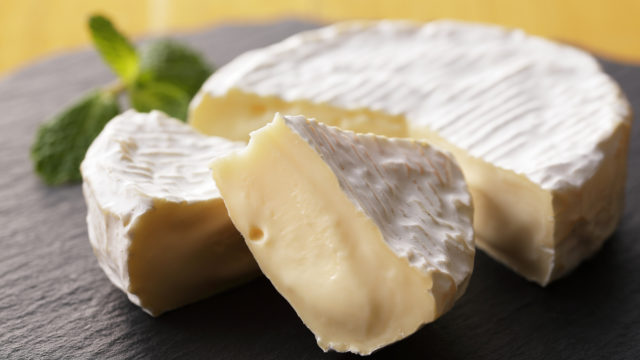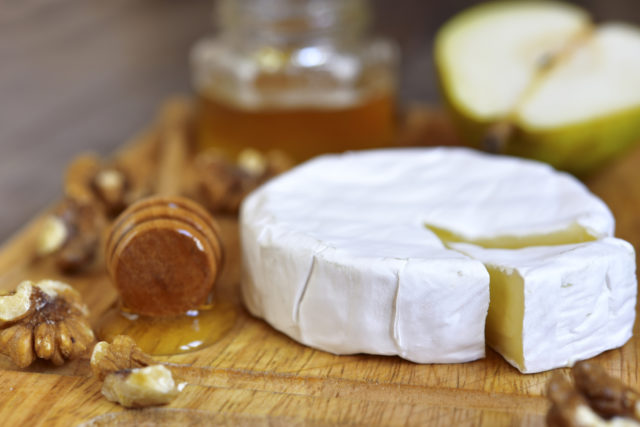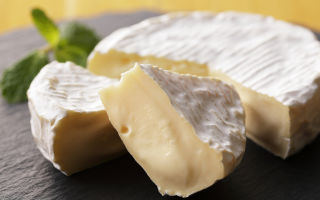Content
- 1 Camembert production technology
- 2 Camembert cheese composition
- 3 How many calories in camembert cheese
- 4 Why Camembert is useful
- 5 How to make camembert at home
- 6 The use of camembert cheese in cooking
- 7 How Camembert is Different from Brie Cheese
- 8 Camembert harm
- 9 How to choose and store Camembert
- 10 Conclusion
The benefits and harms of Camembert are the subject of discussion for many gourmets. It is a gourmet French dish. The use of this type of cheese is welcomed by nutritionists around the world. It has an interesting taste and a rich content of substances useful for the body.
Camembert production technology
Camembert is called a cheese made from cow's milk, covered with a layer of noble mold. It has a delicate taste with salty mushroom notes. Camembert cheese comes on sale in the form of a half-cylinder or a cylinder weighing up to 400 g. It is made from pasteurized milk, the acidity of which varies from 22 to 24 ° T. To achieve such indicators, 1-3% of milk streptococcus starter is introduced into it. When the initial acidity of milk increases by 1-1.5 ° T, rennet is added to it.
The coagulability of milk is carried out within 60 minutes at a temperature of 29 to 32 ° C. After adding rennet, the mixture is poured into tubs with a volume of 40 liters. They curdle milk. On a production scale, specialized tipping baths are used for this.
The finished curd is placed in molds without a bottom made of stainless material. From below they are covered with draped mats. The process of compacting the clot using molds is carried out at a temperature of 18-20 ° C. It takes almost a day. During this period, the cheese is periodically turned over. After removing the product from the molds, it is left for 2 hours. Then the cheese is dipped in a saline solution, the temperature of which is 16-18 ° C.

After 1 hour, they take it out. It is important not to overexpose the cheese, as excessive salinity cannot be eliminated. The cheese drying process is carried out within a week. In this case, the air temperature should be 14-16 ° C, and the humidity should be within 85%. Full maturation requires the presence of aerobic microflora on the surface of the cheese.
Camembert cheese composition
The benefits of white-mold Camembert cheese are due to its rich composition. It is represented by amino acids, minerals and vitamins, essential for the body. A distinctive feature is the increased content of phosphorus and calcium. It is believed that eating 100 g of cheese helps to meet half of the body's daily need for nutrients. Camembert contains the following components:
- vitamins of group B, PP, A, E, D and H;
- iron;
- magnesium;
- amino acids;
- potassium;
- saturated fatty acids;
- zinc;
- Omega-3 and Omega-6;
- organic acids.
Among the amino acids that make up Camembert are tryptophan, valine, histidine and arginine. They are not synthesized in the human body. Therefore, their intake in food is extremely important for health. The rich mineral content is equally important. They provide the strength of the musculoskeletal system.Fatty acids take part in metabolic processes.
How many calories in camembert cheese
The calorie content of Camembert per 100 grams is 324 kcal. The mass fraction of fat is 60%. Therefore, Camembert is not classified as a dietary product. BZHU is presented in the following ratio:
- proteins - 15.3 g;
- fats - 28.8 g;
- carbohydrates - 0.1 g.
Why Camembert is useful
Camembert has some very specific characteristics. It has a gooey soft yellow texture. A liquid forms where the cheese is cut. The crust surface is completely covered with mold. The variety is distinguished not only by its interesting taste, but also by a lot of useful properties. It helps to strengthen the musculoskeletal system and normalizes the intestinal microflora. Useful properties of Camembert:
- prevention of caries;
- strengthening teeth and bones;
- maintaining heart health;
- increased immunity;
- improved absorption of calcium;
- thinning blood;
- sunburn protection;
- acceleration of the regeneration process;
- strengthening of blood vessels.
Camembert is especially useful during the recovery period after fractures. Due to the rich content of minerals, it accelerates the process of bone tissue fusion and prevents possible complications.
Camembert during pregnancy
Many women are interested in whether Camembert can be pregnant. Experts do not recommend adding this product to the diet. Once in the body, it can create favorable conditions for the development of listeria. In pregnant women, this disease manifests itself more intensely due to reduced immunity. It is accompanied by symptoms characteristic of ARVI. The situation is further complicated by the fact that the disease requires antibiotic therapy, which is undesirable during pregnancy. The most suitable substitutes for Camembert in this case are parmesan, gouda, mascarpone and Russian cheeses.

Camembert while breastfeeding
Camembert with HV is not recommended to use earlier than six months after childbirth. Cheese not only provokes the development of Listeria during this period, but also contributes to the violation of the stool in the child. Breastfeeding experts advise replacing this strain with any one without mold.
How to make camembert at home
Camembert can also be obtained at home. The principle of preparation is not much different from industrial production. The following components are involved in the recipe:
- 9 liters of milk;
- 1 ml rennet;
- saline solution.
Cooking process:
- The milk is heated to a temperature of 27 ° C, after which rennet is added to it. The mass is thoroughly mixed and left for a while.
- After 2 hours, a clot should form. It is carefully laid out on a mold and left to drain overnight.
- The next day the cheese is turned over in the mold.
- It is dipped in a saline solution when a dry crust forms on top. After 1 hour, the cheese is taken out and left to dry.
- Then the product is transferred to a room with a temperature of 13 ° C. It is stored there until mold forms.
- The next step is to put the cheese in a room with high humidity and a temperature of 10 ° C.
- During maturation, the color of the mold can change from white to reddish.
- When the core hardens, a product can be considered mature.
The use of camembert cheese in cooking
Due to its amazing taste, Camembert is widely used in cooking. The main feature of the cheese is its thin middle. Gourmets appreciate it for its delicate mushroom flavor with moderate salinity. It is often used to create a cheese platter.Sometimes culinary experts include Camembert in the fillings of pies, pizzas and other pastries.
In France, the delicacy is often baked and fried in breadcrumbs. Before baking, the top is cut off, and then sprinkled with chopped garlic and lemon zest. Camembert is also a popular ingredient in sauces and traditional soups. It is sometimes added, even to cappuccino. It increases the nutritional value of the drink and gives it an unusual taste. The cheese goes well with red wines, Norman pears and crunchy country bread. Its taste is well set off by almonds and grapes. White wines are often used to tone down the pungency of the cheese.

How Camembert is Different from Brie Cheese
Camembert is often confused with brie cheese. For the preparation of both varieties, identical technologies are used. Unlike Camembert, Brie contains cream. Due to this, it has a higher fat percentage.
You can distinguish one variety from another by its appearance. Brie cheese has a firmer crust and a bulkier shape. It has a white or grayish tint. The Camembert head is slightly flattened. Internally, the brie is lighter than Camembert. In addition, it has a pleasant nutty aroma and a more delicate mushroom flavor.
Camembert harm
In the absence of contraindications and moderate use, Camembert does not harm health. Problems can only arise if used incorrectly. With low immunity, cheese can provoke the appearance of listeria. When consumed in excessive amounts, it can contribute to weight gain. Contraindications for the product include:
- fungal diseases;
- high blood pressure;
- excess weight;
- lactation and pregnancy period;
- high blood cholesterol;
- age less than 7 years;
- neurodermatitis;
- asthma.
How to choose and store Camembert
When choosing a Camembert, you should be guided by the information on the package. Real cheese is produced in Normandy or France. However, even this does not guarantee that it is made according to the correct recipe. Sometimes cheese is prepared in these countries, but using milk from other countries. In order not to fall for this trick, you should find the inscription "Camembert de Normandie" on the packaging. It indicates the high quality of the product.
In this case, the packaging must be wooden. It is equally important to study the composition of the product. Among the main ingredients, the bacterium Penicillium camemberti should be present. Cheese is considered to be of high quality, the fat content of which is 45%.
The average weight of a cheese head is 340 g. Only minor deviations from this norm are possible. The degree of ripening of a product can be judged by the color of its surface. The darker it is, the longer the cheese has matured. A repulsive product is considered the absolute norm. Slime formed on the cheese is also considered acceptable.
The delicacy should be stored at temperatures ranging from + 5 to 10 ° C. Storage is carried out in its original packaging. But you can also put the cheese on wax paper. If stored in plastic bags and plastic containers, the product will deteriorate quickly. This will be evidenced by its drying out. It is also permissible to increase the safety of the product by shock freezing. But in this case, the taste of the cheese may change slightly. The process of defrosting the product must be carried out naturally. The shelf life of Camembert, if all conditions are met, is 25 days.
Conclusion
The benefits and harms of Camembert, one way or another, relate to the presence of mold in the composition. Depending on the circumstances, it can both harm and have a positive effect on the body. Along with this, it gives a delicate and unusual taste to the product.

